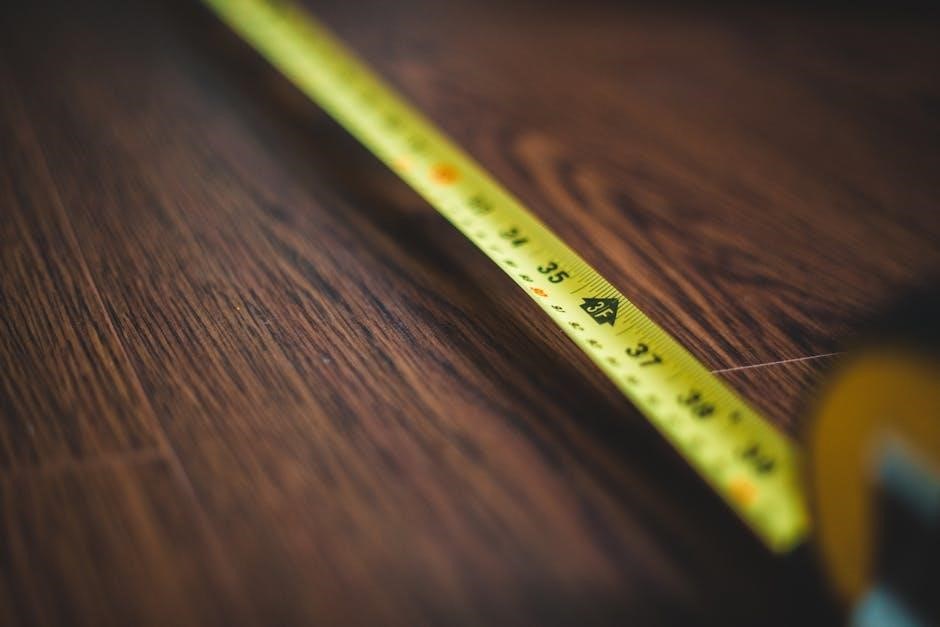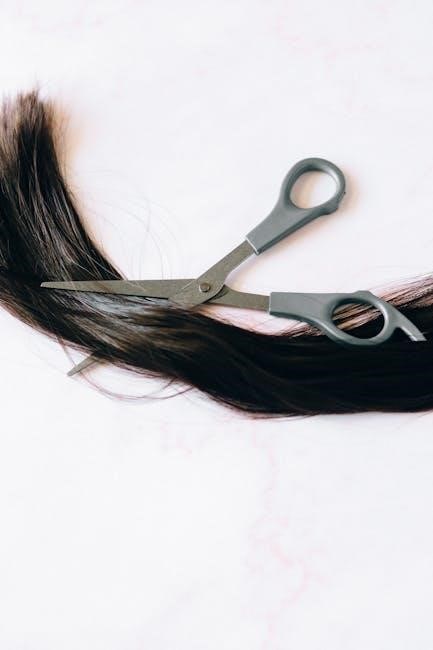
putter length guide
A putter length guide helps determine the ideal club length for consistent strokes. Proper fitting enhances alignment‚ comfort‚ and performance‚ ensuring optimal results on the green.
1.1 Understanding the Importance of Putter Length
Proper putter length is essential for a consistent stroke‚ as it directly impacts alignment‚ posture‚ and overall performance. A well-fitted putter ensures the clubface aligns squarely with the target line‚ promoting accurate rolls. Incorrect length can lead to inconsistent strokes‚ poor ball striking‚ and missed putts. Comfort and confidence are also enhanced with the right length‚ allowing golfers to maintain a stable setup. While standard lengths exist‚ individual factors like height‚ posture‚ and stroke type make customization crucial. Understanding these principles is key to improving your putting game and overall scoring potential;
1.2 Overview of the Guide
This guide provides a comprehensive approach to selecting the ideal putter length‚ covering key factors like height‚ stroke type‚ and posture. It explains measurement techniques‚ fitting processes‚ and customization options to ensure optimal performance. The guide also explores common mistakes to avoid and offers practical tips for testing different lengths. By addressing both standard lengths and individual preferences‚ it aims to help golfers of all skill levels find a putter that enhances their alignment‚ comfort‚ and overall putting consistency. This resource is designed to simplify the process of achieving the perfect fit for improved results on the green.
Factors Determining Putter Length
Putter length is influenced by a golfer’s height‚ stroke type‚ posture‚ and personal comfort. These elements collectively determine the optimal fit for consistent and accurate putting performance.
2.1 Height and Its Impact on Putter Length
A player’s height significantly affects putter length‚ as it determines how the club sits during the address. Taller golfers typically require longer putters to maintain proper posture‚ while shorter players may prefer shorter lengths. A putter that matches the golfer’s height ensures the hands and arms align correctly‚ promoting a consistent stroke. Proper length prevents slouching or reaching‚ which can disrupt balance and alignment. Height is a fundamental starting point for selecting the right putter length‚ though other factors also play a role in the final decision.
2.2 Stroke Type and Putter Length
The type of putting stroke significantly influences the ideal putter length‚ as different techniques require varying club lengths for optimal performance. A straight-back putting stroke may benefit from a slightly longer putter to maintain a consistent path‚ while an arc stroke might require a shorter length for better control. Additionally‚ players with a strong arc or pendulum-style stroke often prefer shorter putters to enhance feel and accuracy. Matching the putter length to the stroke type ensures a smoother‚ more consistent roll‚ improving overall putting performance and confidence on the green.
2.3 Posture and Address Position
Posture and address position play a crucial role in determining the optimal putter length. A player’s stance‚ including knee bend and spine angle‚ affects how the putter aligns with the ball. Standing too upright may require a shorter putter‚ while a more bent posture might need a longer one. Ensuring the putter aligns with the eyes and hands at address is vital for consistent strikes. Proper posture and alignment help maintain a stable putting stance‚ directly impacting accuracy and overall performance on the green.
2.4 Personal Preferences and Comfort
Personal preferences and comfort significantly influence putter length choices. Players often choose lengths that feel natural‚ allowing for a consistent pre-shot routine and stroke. Comfort affects confidence‚ which is critical for making precise putts. Some golfers prioritize a specific feel or balance‚ while others adjust based on past experiences. Ultimately‚ the right putter length is one that aligns with individual comfort‚ enhancing performance and overall satisfaction on the course. It’s essential to experiment and find the length that best suits personal preferences for optimal results.

Standard Putter Lengths
Standard putter lengths typically range from 33 to 35 inches‚ accommodating various golfer heights and preferences. These lengths ensure proper posture and alignment for consistent strokes.
3.1 33-Inch Putter
A 33-inch putter suits shorter golfers or those with a more upright posture. It allows for better control and alignment‚ promoting a consistent stroke. Ideal for players under 5’8″ who prefer a compact setup‚ this length ensures the club sits comfortably against the body. Many find it easier to maintain a straight line with the target‚ enhancing accuracy. However‚ taller golfers may find it too short‚ leading to discomfort. Proper fitting is essential to maximize performance with this length.
3.2 34-Inch Putter
A 34-inch putter is a popular choice‚ balancing comfort and performance for most golfers. It suits those between 5’8″ and 5’11″‚ offering a natural swing path. This length allows for a slight bend in the knees‚ promoting a consistent address position. Many players find it ideal for maintaining proper posture without compromising control. Its versatility makes it a favorite among both professionals and amateurs‚ ensuring a smooth stroke and accurate alignment. This length is often recommended for its adaptability to various putting styles and body types.
3.3 35-Inch Putter
The 35-inch putter is ideal for taller golfers‚ typically those over 6 feet‚ providing a more upright posture. It minimizes back strain and aligns the eyes directly over the ball‚ enhancing accuracy. This length is standard for players with longer arms or those who prefer a slightly taller address position. While it suits taller individuals‚ some shorter golfers also opt for this length‚ gripping lower to simulate a shorter putter. Its adaptability and ergonomic benefits make it a versatile choice for various player preferences and physical needs.

Measuring for the Correct Putter Length
Measuring for the correct putter length involves assessing your posture‚ address position‚ and personal comfort. Using a putter fitting chart ensures the best fit for your stroke.
4.1 How to Measure Your Putter Length
To measure your putter length‚ assume your address position and bend your knees slightly. Let your arms hang naturally‚ then measure from the center of the club face up the shaft to the butt end of the grip. This ensures the putter length aligns with your posture and stroke. Using a putter fitting chart can help confirm the ideal length based on your height and setup‚ ensuring comfort and consistency during your putting stroke.
4.2 Using a Putter Fitting Chart
A putter fitting chart is a valuable tool to determine the ideal length based on your height‚ posture‚ and stroke type. It correlates these factors to recommend a specific putter length‚ ensuring proper alignment and comfort. Club fitters often use these charts to guide their recommendations‚ considering individual preferences and setup. By referencing the chart‚ you can identify the optimal length to enhance your putting performance and consistency. It’s a practical starting point for golfers seeking a tailored fit for their game.

Putter Fitting and Customization
Putter fitting involves adjusting length‚ lie angle‚ and loft to match your stroke and posture. Customization ensures optimal alignment‚ improving consistency and overall putting performance.
5.1 The Role of a Club Fitter
A club fitter specializes in analyzing your swing and posture to recommend the ideal putter specifications. They consider height‚ stroke type‚ and personal preferences to optimize performance. By using advanced tools and expertise‚ they ensure the putter’s length‚ lie angle‚ and loft align perfectly with your unique needs. This personalized approach enhances consistency‚ accuracy‚ and overall putting performance‚ helping you achieve a more confident and effective stroke. A professional fitting session is a valuable investment for golfers seeking precision and improvement in their game;
5.2 Adjusting Lie Angle and Loft
Adjusting the lie angle and loft of your putter ensures proper alignment and ball striking. The lie angle affects how the club approaches the ball‚ while loft influences the ball’s initial trajectory. Proper adjustments prevent twisting during impact‚ leading to straighter‚ more accurate putts. A club fitter can tailor these specifications to your stroke mechanics‚ ensuring consistent performance. This customization is crucial for optimizing control and achieving a smoother roll‚ ultimately enhancing your overall putting effectiveness and consistency on the greens.
5.3 Weight Distribution in Putters
Weight distribution in putters plays a crucial role in balance and stability. Modern putters often feature strategically placed weights to enhance MOI (moment of inertia)‚ improving forgiveness on off-center hits. Heavier heads can provide a solid feel‚ while lighter designs allow for better control. The distribution of weight impacts the putter’s responsiveness and alignment capabilities. Proper weight balance ensures consistent rolls and aids in maintaining a smooth stroke. This customization‚ combined with optimal length‚ helps golfers achieve greater accuracy and confidence on the greens.
Tips for Testing Putter Length
Test different lengths on the practice green to assess comfort and accuracy. Grip down on longer putters to simulate shorter lengths and evaluate performance consistency.
6.1 Trying Before Buying
Testing putter lengths before purchasing is crucial for assessing comfort and performance. Visit a practice green to experiment with different lengths‚ focusing on alignment and stroke consistency. Pay attention to how each length feels during your swing and impact. For taller golfers‚ longer putters may improve posture‚ while shorter options suit those with more upright stances. Grip down on longer putters to simulate shorter lengths and vice versa. This hands-on approach ensures you find the ideal fit‚ enhancing your putting accuracy and confidence on the course. Always prioritize feel and performance over standard recommendations.
6.2 Practicing with Different Lengths
Practicing with various putter lengths helps identify the most comfortable fit. Start by testing standard lengths like 33‚ 34‚ and 35 inches. Focus on how each length affects your posture‚ alignment‚ and stroke consistency. For taller golfers‚ longer putters may reduce back strain‚ while shorter options suit those with a more upright stance. Experiment on the practice green‚ paying attention to how each length impacts your ability to square the face at impact. This process ensures you find a length that complements your technique and enhances overall performance. Consistency is key to making informed adjustments.
6.3 Using a Putter Length Guide
A putter length guide provides a structured approach to determining the ideal length. It considers factors like height‚ posture‚ and stroke type. By measuring your setup‚ the guide recommends lengths that align with your natural stance. Many guides include charts or formulas to simplify the process. Some also account for personal preferences‚ ensuring comfort and consistency. Using a guide can help identify the optimal length for improved alignment and stroke mechanics‚ making it a valuable tool for golfers of all skill levels to enhance their putting performance.

Adjustments and Modifications
Adjusting putter length involves cutting the shaft or adding extensions to achieve optimal fit. These modifications improve comfort and performance‚ ensuring a consistent and precise putting stroke.
7.1 Cutting the Shaft
Cutting the shaft is a common adjustment to shorten the putter length. This modification is typically done to achieve a better fit for the golfer’s height and posture. Proper measurement is essential to ensure the shaft is cut accurately without compromising the club’s balance. Cutting the shaft can improve alignment and stroke consistency‚ but it requires careful consideration of the golfer’s setup and swing mechanics. Professional club fitters often perform this adjustment to maintain optimal performance and feel.
7.2 Adding Extensions or Reducing Length
Adding extensions or reducing the length of a putter shaft is a common modification to tailor the club to a golfer’s needs. Extensions are often used for taller golfers or those with an upright posture‚ while reducing length suits shorter golfers or those with a more bent-over stance. This adjustment ensures the putter sits correctly at address‚ improving stroke mechanics and alignment. However‚ altering the length can affect weight distribution‚ so it’s crucial to test the feel and performance after modifications. Always consult a professional fitter for precise adjustments.

Common Mistakes in Choosing Putter Length
Neglecting posture‚ ignoring stroke type‚ and not testing putters before purchase are common mistakes that can hinder a golfer’s performance on the green.
8.1 Ignoring Posture and Stroke Type
Ignoring posture and stroke type is a common mistake when selecting putter length. Posture significantly affects how the club sits during the address‚ influencing alignment and comfort. A mismatched putter length can lead to an inconsistent stroke‚ reducing accuracy and control. Additionally‚ stroke type—whether it’s an arc or straight-back-and-through—plays a role in determining the ideal length. Failing to consider these factors often results in poor performance and discomfort during play. Proper fitting ensures the putter aligns with personal swing characteristics for better results.
8.2 Not Testing Before Purchasing
Not testing a putter before purchasing is a significant oversight. Without trying it‚ golfers risk discomfort and poor performance. Testing allows players to assess how the putter feels during the stroke‚ ensuring proper alignment and consistency. Skipping this step often leads to mismatched equipment‚ affecting accuracy and control. Many golfers regret purchases made without testing‚ as the putter may not suit their posture‚ stroke type‚ or personal preferences. Always test putters on the green to confirm they align with individual swing characteristics and provide a comfortable fit.

Putter Length and Performance
Correct putter length enhances consistency‚ alignment‚ and stroke quality‚ directly impacting overall performance. Proper fitting ensures optimal ball control and accuracy‚ elevating your golf game significantly.
9.1 Impact on Alignment and Accuracy
A properly fitted putter length ensures consistent alignment and accuracy. Incorrect lengths can disrupt posture‚ causing the face to misalign at impact. A putter that’s too long may force an upright stance‚ while one that’s too short can lead to a hunched position‚ both affecting aim. The correct length allows the face to square naturally‚ promoting a consistent setup and stroke. This alignment stability enhances distance control and reduces mishits‚ ultimately improving overall putting performance and confidence on the green.
9.2 Effect on Distance Control
Putter length significantly influences distance control‚ as it affects the stroke’s consistency and tempo. A properly fitted putter allows for a smoother‚ more controlled motion‚ reducing variability in speed and direction. Incorrect lengths can lead to inconsistent ball striking‚ making it harder to gauge distances. A well-suited putter length ensures a balanced pendulum stroke‚ improving the ability to judge and replicate roll distances accurately. This consistency is crucial for making reliable putts and achieving better scoring outcomes on the course.
Choosing the right putter length is crucial for improving alignment‚ consistency‚ and overall performance‚ ensuring a more enjoyable and successful golfing experience with proper customization and fit.
10.1 Final Thoughts on Putter Length
Proper putter length is essential for consistent alignment‚ stroke‚ and overall performance. Factors like height‚ posture‚ and stroke type significantly influence the ideal length. Testing different lengths and customizing the putter to fit personal preferences can greatly enhance accuracy and control. Avoid common mistakes‚ such as ignoring posture or not testing before buying‚ to ensure the best fit. By prioritizing these elements‚ golfers can improve their putting performance and enjoy a more satisfying game with better alignment and distance control.
10.2 Encouragement to Experiment and Find the Right Fit
Experimenting with different putter lengths and styles is crucial for finding your ideal fit. Don’t hesitate to try various lengths and setups to see what feels most comfortable and aligns with your stroke. Professional fittings can provide valuable insights‚ but personal testing is equally important. Remember‚ the right putter length enhances alignment‚ consistency‚ and performance. Take the time to explore your options and discover the setup that elevates your game. Your putting potential depends on it—don’t settle until you find perfection.